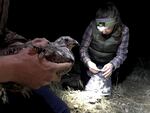
Lindsey Perry prepares a tag for a female sage grouse.
Courtney Flatt / NWPB/EarthFix
Hiding somewhere in the sagebrush on a wide-open area were dozens of sage grouse. It was dark. So dark it seemed you can see nearly every star.
“That’s the seven sisters, the little, little dipper, next to the bull Orion’s shooting at,” Todd Stansbery pointed to the sky.
It was cold. And it was quiet.
Perfect conditions for these researchers to find sage grouse hens.
“Actually let me just show you what we’re doing,” said Lindsey Perry. She's a doctoral student at Oregon State University and a colleague of Stansbery, a field technician with the university.
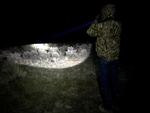
Zach Slick shines a spotlight to look for the glimmer of sage grouse eyes. He's helping out with research that is looking into how ravens are affecting imperiled sage grouse.
Courtney Flatt / NWPB/EarthFix
"The other day we saw a bunch of males,” she said, pointing to her GPS device. “We’re only collaring females. So we’re just going to try a different path to try to cover more ground.”
Perry has spent much of the last several months around Baker City in Eastern Oregon. She’s monitoring sage grouse hens — along with one of their most resourceful predators in the area: ravens.
A Problem For Sage Grouse
Sage grouse are found in 11 Western states. But they’re in trouble.
In Oregon, their fragmented habitat is threatened by human development, invasive species, wildfires and overgrazing. Researchers are just starting to look into raven depredation, a more controversial problem for the birds.
In a policy shift, the federal government wants sage grouse work to focus on the predators.
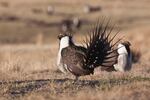
A University of Wyoming research team is working with Western ranchers to develop a model to calculate the economic impacts of sage grouse conservation on ranchers.
Bob Wick, Bureau of Land Management/Flickr
Perry hopes to figure out just how bad the raven problem is here in Baker City.
“It’s just you’re putting a really strong species against one that’s just not. The sage grouse are not as smart or as capable as the ravens,” she said.
Ravens will eat sage grouse eggs out of their nests. That starts happening after April when breeding season usually begins.
Perry said any sort of hit to the group of sage grouse here could be the final blow.
The sage grouse population in this area has declined by about 75 percent since 2006. Biologists say this population hasn’t bounced back from its low point at the same rate as many other groups of sage grouse in Oregon. The birds are native to the Northwest's high-desert country east of the Cascades.
“The Baker population of sage grouse has plummeted in the last decade. The problem with that is it’s an isolated population. So once it’s gone, it’s not likely to come back,” Perry said.
Here's A Hen
That’s why she was out in the dark, scanning the landscape with a spotlight for a few glowing sage grouse eyes.
“They’re like little blue, purple diamonds,” Perry said.
The group walked for hours through the remote Bureau of Land Management land. A white noise machine masked the sound of their approaching footsteps.
Finally, technician Zach Slick spotted something hidden beneath a clump of sagebrush. It was a hen that had been spooked and flown away earlier in the evening.
“I knew it. She was sitting behind this thing the whole time,” he whispered.
They quickly set the spotlight to stun mode. It blinked, turning the dark landscape into a momentary disco dance floor. The sage grouse stayed put — frozen in the light. The researchers swung a net, landing it right over a female sage grouse.
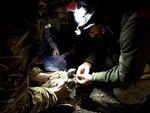
Todd Stansbery attaches a transmitter to a female sage grouse.
Courtney Flatt / NWPB/EarthFix
"This is great, guys. Zach, do you want to hold her? And we’ll have Todd process her,” Perry directed the crew.
She fished out a transmitter band to fit around the hen’s neck — extra jewelry, she joked. The transmitter will track the bird’s movements.
“The way that this goes on is you’ll stretch it and put it on her,” she said.
“That’s on her pretty good,” Stansbery said as he tightened the device.
“Awesome,” Perry said. “We’re done with her. Going to throw her out into the world again.”
'It's Kind Of A Shame'
Ranchers, conservationists, biologists and the federal government came together in 2015 to help develop state-specific plans to protect the birds across the Intermountain West — and keep their numbers up enough to avoid a decision that the birds need to be protected under the Endangered Species Act. That would likely trigger even greater land-use restrictions across 11 western states.
The health of the sage grouse population is linked to the overall health of sagebrush — and the more than 350 other species this vast landscape supports: wildlife like pronghorn antelopes, pygmy rabbits and western burrowing owls.
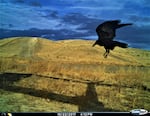
A raven flies by a trail camera near bait that researcher Lindsey Perry placed.
Courtesy of Lindsey Perry
But when it comes to the well-being of sage grouse, there are too many ravens on the landscape near Baker City. Research has found nearly half of sage grouse nests don’t hatch babies in places like this, with about one raven every two square kilometers.
“(In that research) you’re starting to see sage grouse nest success levels decline to a point where sage grouse populations begin to fall as well,” said Lee Foster, sage grouse coordinator with the Oregon Department of Fish and Wildlife.
Foster's agency is contracting with Wildlife Services to kill some of the ravens near Baker City. It's a short-term solution. But it could help the sage grouse survive while biologists figure out what's going wrong with the birds here, Foster said.
“You know, it’s kind of a shame that we have to consider doing this because ravens are such cool critters,” Foster said. “I don’t think any wildlife biologist out there wants to undertake this sort of work. But, I think, if we want to maintain sage grouse on the landscape, we have to consider all of the actions that are available to us to do that.”
Conservation groups say there is simply not enough data to justify killing ravens in Baker County.
"Killing ravens is really just a way to divert attention and scapegoat a natural predator for problems that we’ve created,” said Bob Sallinger, conservation director with the Audubon Society of Portland.
Sallinger said his group would consider filing a lawsuit or taking other actions to prevent the killing of ravens near Baker City.
In 2014, Idaho Fish and Game had to postpone plans to kill ravens in an effort to help greater sage grouse in the southern part of the state, after a federal environmental assessment wasn't completed on time. The program faced a lot of pushback from critics.
Better Habitat Or Fewer Predators
Interior Secretary Ryan Zinke has started to review the formal plans to better protect sage grouse, bringing into question Obama-era plans to better protect sage grouse and keep them off the endangered species list. Those plans took decades of work — and lots of compromises between conservationists, ranchers, and biologists.
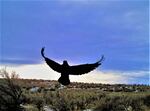
A raven lands to eat bait that researcher Lindsey Perry placed earlier.
Courtesy of Lindsey Perry
Some industry groups were unhappy with the plans. So Zinke wants to weaken sage grouse habitat protections. And he wants more study of their population numbers, with an emphasis on threats from predators, like ravens.
It’s an idea conservation groups say is not supported by research. To protect the imperiled birds, Sallinger said, it’s much more important to protect and improve their habitat.
If the administration gets its way, Sallinger said, “I think what’s ultimately going to happen is you’re going to continue to see declines, and you’re going to see moves to try and list the species within a few years.”
Trapping Ravens, Too
There’s still a lot of be learned about sage grouse — and for that matter how ravens affect sage grouse, especially in Oregon’s Baker County.
That’s why Perry and fellow researchers have spent so much time here and at their other experimental sites around the state. She hopes to figure out how much of an effect the lethal raven removal has on sage grouse.
Perry wants to know why ravens are doing so well in Baker City: Is it all the roads with abundant roadkill? All the barns with easy access to mice? The irrigation and farming equipment and power lines on which to perch?
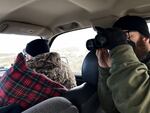
Todd Stansbery, right, and Zach Slick watch the raven traps they just set. They are helping out with research looking into how ravens are affecting sage grouse near Baker City, Oregon.
Courtney Flatt / NWPB/EarthFix
"Are ravens getting a foot in the door with all of our infrastructure out there?” Perry said.
She’s also looking at ways to funnel ravens away from sensitive sage grouse habitat: things like perch deterrents, moving roadkill away from important sage grouse space, picking up dead cattle from landowners.
“I’m open to any ideas,” she laughed.
At this point in her research, she’s trying to get an estimate of how many ravens are in the area. To do that, the researchers headed back into the cold, predawn darkness to set traps for ravens.
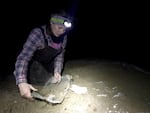
Lindsey Perry sets a trap for ravens. She wants to tag ravens so that she can see how they are affecting sage grouse. The traps must be well camouflaged in the dirt.
Courtney Flatt / NWPB/EarthFix
"They’re leg-hold or foot-hold traps,” Perry said. “It’ll clamp down on the raven’s leg whenever they step down and put pressure on it. They do kind of move around quite a bit, but those anchors keep them secured until we can get down there.”
The ravens this morning are too skittish and too skeptical of Perry’s pickup, waiting high on a bluff. They're a hundred yards away from the brown chicken eggs and an elk head she had laid out as bait.
“We’re in a big white truck. I wish this truck wasn’t white,” she said watching ravens soar above but avoid landing near the traps. “I’m starting to wonder if we need to wear masks because not only can they recognize individual humans, but I think that they can portray that to other ravens.”
The researchers didn’t capture any ravens that early morning. But they would keep trapping. The way Perry sees it, getting trapped could be in the birds' best interest.
“I would love to get ravens somewhat off the hook," she said. "I would like to say that the sage grouse aren’t a big source of their diet.”
